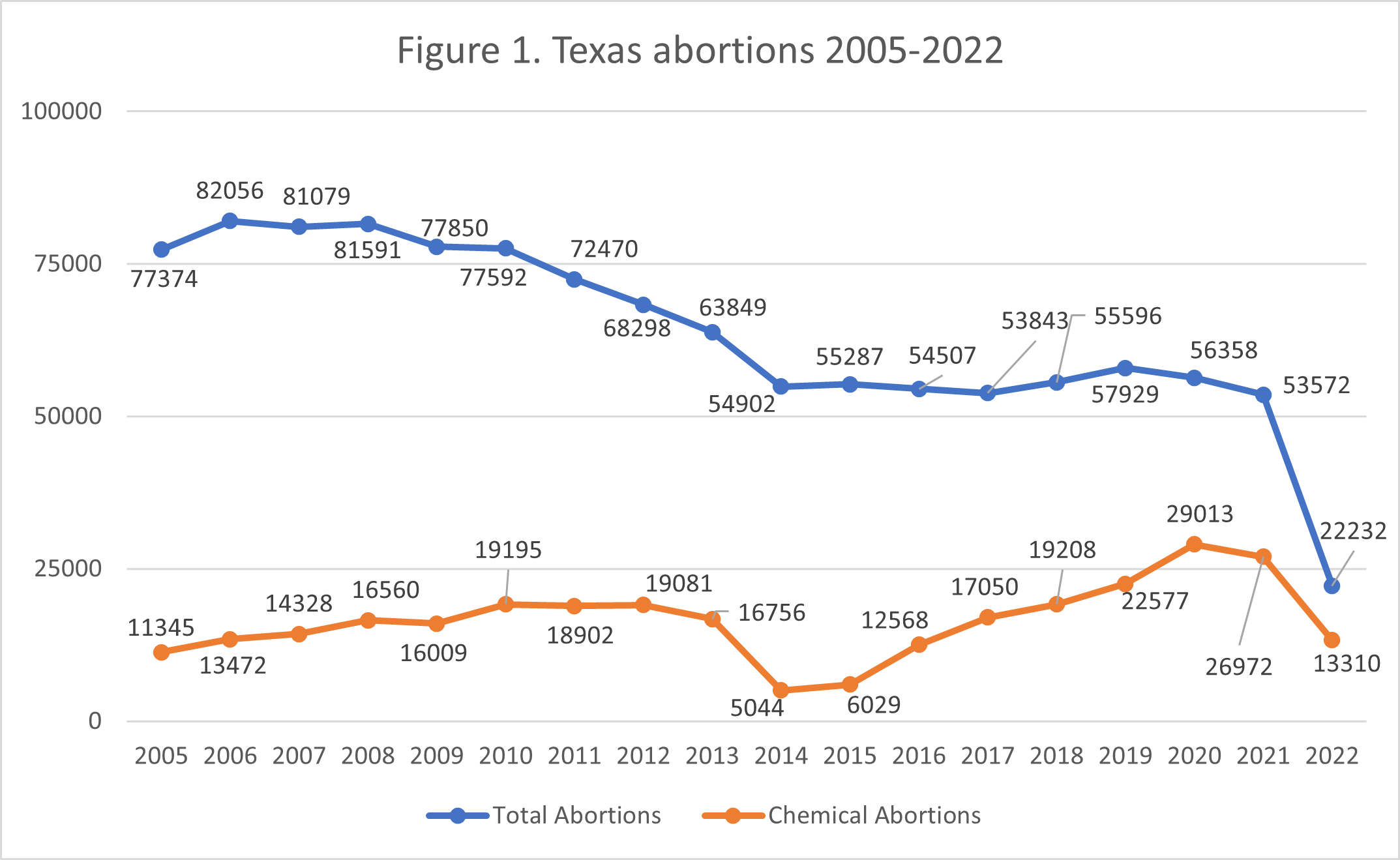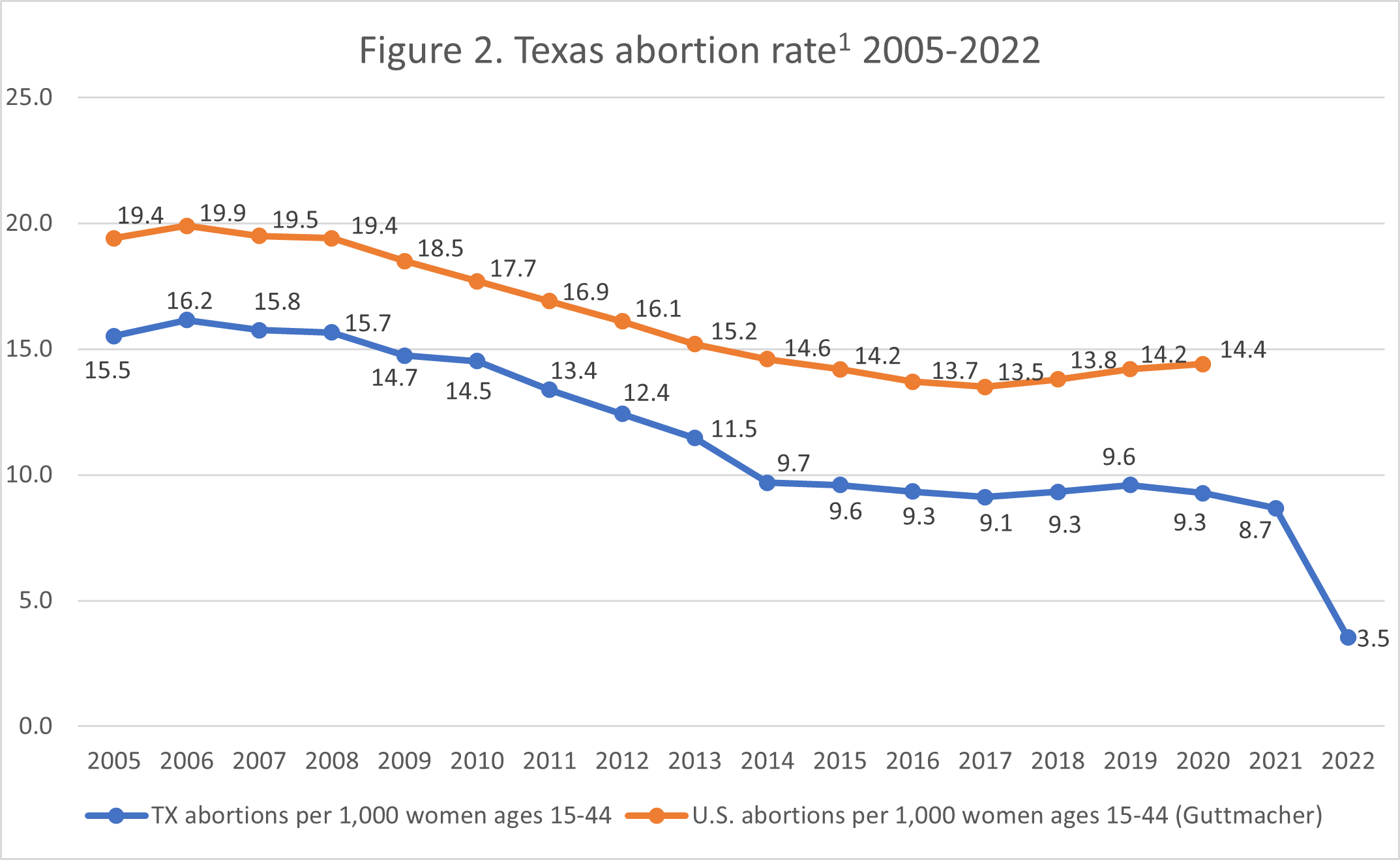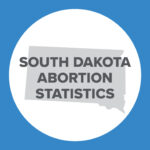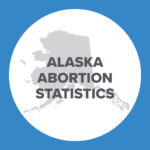Abortion Reporting: Texas (2022)
Texas’ 2022 abortion report was released by Texas Health and Human Services in September 2023, showing a significant drop in abortions from 2021.
Statistics and Changes in Texas Abortions, 2021-2022

This report does not include information on Planned Parenthood’s Texas abortion market share. However, no Planned Parenthoods in Texas perform abortion.
Abortion Totals and Trends
In 2022, there were 22,232 Texas abortions reported, a drop of 59% from 2021. Similarly, chemical abortions decreased by a significant percentage, 51%, from 26,972 in 2021 to 13,310 in 2022 (Fig. 1). Chemical abortions made up 60% of Texas abortions in 2022. The Charlotte Lozier Institute (CLI) estimates that Texas’ abortion rate also fell by 59% to 3.5 abortions per 1,000 women ages 15 to 44 (Fig. 2).1 Abortions performed in Texas dropped by 66%. As of October 2023, 23 states have released 2022 statistics, of which 10 reported that abortions had decreased from 2021.
State Report Summary
Texas abortions include abortions performed in Texas on residents and nonresidents, as well as abortions performed on Texas residents in other states. In 2022, 77% of Texas abortions were performed on state residents in Texas (a large decrease from 95% in 2021), 1% were performed on nonresidents in Texas, and 21% were performed on Texas women in other states (an increase of 176% from 2021).
In 2022, 8% of Texas abortions were performed on girls under the age of 20. Thirty percent of the abortions were obtained by women ages 20 to 24, and 29% were performed on women ages 25 to 29. Twenty percent of the abortions were performed on women ages 30 to 34 and 10% on women ages 35 to 39. Three percent were performed on women ages 40 and older.
Hispanic women made up the largest group of women undergoing Texas abortions, comprising 36% of the total in 2022. Thirty-two percent of the abortions were on black women, and 25% on white women. Four percent of Texas abortions were performed on Asian women, 0.3% were on Native American women, and 1% were on women of other races. Race was not reported for 1% of the abortions. CLI estimates that Texas’ black abortion rate was 8.3 abortions per 1,000 women ages 15 to 44, three times the white rate of 2.5, while the Hispanic rate was 2.9.
Sixty percent of Texas abortions were chemical. Thirty-seven percent were suction curettage procedures, and 1% were conducted via dilation and evacuation. There were six sharp curettage abortions (0.03%) and one hysterectomy or hysterotomy abortion. The type of procedure was not reported for 2% of the abortions.
A majority of Texas abortions, 93%, occurred before nine weeks post-fertilization (approximately 11 weeks of gestation). Three percent were performed between nine and 10 weeks post-fertilization, and 2% were reported between 11 and 12 weeks. One percent of Texas abortions occurred between 13 and 14 weeks post-fertilization, 0.3% between 15 and 16 weeks, and 0.4% from 17 to 20 weeks. There were three abortions reported between 21 and 24 weeks post-fertilization (23 to 26 weeks of gestation) and no abortions at 25 weeks post-fertilization or later. The post-fertilization age was not reported for seven abortions.
Less than half of Texas abortions (44%) were performed in licensed abortion facilities, and 34% were reported by ambulatory surgery centers. There were 35 abortions performed in hospitals (0.2%), while zero abortions were reported to have occurred in physicians’ offices. Twenty-one percent of the abortions were performed out of state.
Texas’ 2022 abortion report includes the first full year of data for expanded complication reporting required under Texas Health and Safety Code (HSC) 171.006. These new requirements were added by S.B. 4, which was signed into law by Texas Governor Greg Abbott in 2021 and went into effect on December 2 of that year. The additional complications that must be reported according to the state’s complication reporting law, originally passed as H.B. 13 in 2017, include failure to actually terminate the pregnancy, endometritis, and missed ectopic pregnancy, among others, along with any other adverse event as defined by the United States Food and Drug Administration’s (FDA) criteria provided by the MedWatch Reporting System.
In addition to changes made to complications reporting, in 2021 the Texas legislature passed S.B. 8 (the state’s heartbeat law), which also contains a requirement that if an abortion is performed due to a medical emergency or a threat to a woman’s physical health those reasons must be included in the physician’s abortion report submitted to the state. This information is only collected for abortions on Texas residents in and outside of Texas. In 2022, only two abortions were performed because of a medical emergency, 39 to preserve the physical health of a woman, 33 for both emergency and health reasons, and 21,856 for neither health nor emergency reasons. Of the abortions performed for neither health nor emergency reasons, 17,179 occurred in Texas, almost all of which were performed in June or earlier.
In 2022, Texas received 197 complication reports from facilities, including 10 duplicate forms.2 Multiple complications can be reported on each form, and multiple forms could be submitted for a single patient or complication. Although duplicates are included in the total number of reports received, Texas removes duplicates from the count before reporting the total number of complications. In 2022, 211 complications were reported by facilities.
The most frequent complication was incomplete abortion, which occurred 77 times. There were 32 cases of failure to actually terminate the pregnancy, 25 cases of hemorrhage, 14 cases of infection, six cases of missed ectopic pregnancy, four cases each of endometritis and sepsis, and two cases of shock. There was one case each of aspiration/allergic response, damage to the uterus, blood clots resulting in either a pulmonary embolism or deep vein thrombosis, pelvic inflammatory disease, renal failure, metabolic disorder, preterm delivery in a subsequent pregnancy, fluid accumulation in the abdomen, and adverse reactions to anesthesia or other drugs. There were 36 other, unspecified complications that met the Food and Drug Administration’s definition of “adverse event.” Two babies were reported to have been born alive during an abortion in 2022, though there is no further information reported on the baby’s outcome. There were no abortion-related maternal deaths reported in 2022.
Some of the tables in the report contain information for abortions performed on Texas residents only. In 2022, 86% of the abortions obtained by Texas residents (both in Texas and in other states that shared data with Texas) were performed on unmarried women, while 14% were performed on married women. Forty percent of Texas resident abortions were performed on women with no previous live births. Twenty-three percent were on women with one prior live birth, and 36% were on women with two or more previous live births. Sixty-three percent of Texas resident abortions were obtained by women who reported no previous abortions, 25%by women with one prior abortion, and 13% by women with more than one previous abortion.
Legislative Changes and Subsequent Changes in Abortion Totals by Month
As previously summarized by CLI, Texas’ heartbeat law went into effect on September 1, 2021. The state’s 1925 law that protects life from conception went into effect on the day Roe v. Wade was overturned in June 2022, and Texas’ life at conception law that was passed in 2021 went into effect on August 25, 2022. The life at conception law from 1925 was blocked for part of June 2022 but has been in effect consistently since July 2022, while the state’s heartbeat law was superseded by the 1925 law in June 2022 and then by the 2021 life at conception law. All three laws were challenged in a 2023 lawsuit, Zurawski v. State of Texas. On August 4, 2023 a judge ruled that the heartbeat law violated the state constitution and that the life at conception laws could not apply to abortions performed on women with dangerous pregnancy complications. However, the state immediately appealed this decision and the two life at conception laws are currently in full effect while litigation continues.
The effect of these laws, and their capacity to affect thousands of abortions, is displayed in the 2022 monthly data.
Table 1- Number of Resident Abortions in Texas Before and After the Heartbeat and Life at Conception Laws Went into Effect by Month, 2019-20223
|
Table 2- Totals Abortions in Texas Before and After the Heartbeat and Life at Conception Laws Went into Effect by Post-Fertilization Age in Weeks, 2020-2022
| <=8 | 9-10 | 11-12 | 13-14 | 15-16 | 17-20 | 21-24 | 25+ | Not stated | |
| 2020 | 46448 | 3470 | 2207 | 1427 | 768 | 804 | 8 | 0 | 0 |
| 2021 | 44609 | 3011 | 1786 | 1168 | 611 | 661 | 11 | 2 | 1 |
| 2022 | 17482 | 3 | 1 | 6 | 8 | 11 | 3 | 0 | 7 |
State Ranking
In CLI’s 2016 paper evaluating abortion reporting across the country, Texas’ reporting tied for 15th best. Texas has made great strides since then in improving the state’s complications reporting. However, Texas could improve its reporting by reporting the states from which it did or did not receive data on abortions performed on Texas women.


- National rates were calculated by the Guttmacher Institute. Texas rates were calculated by CLI using the following formula: (total number of abortions performed in Texas ÷ number of resident women ages 15-44 [based on most recent population estimates]) x 1,000. Rates may differ slightly from previous CLI articles due to revised population estimates. Population estimates were obtained from the CDC WONDER database. Estimates for 2005-2009 are intercensal estimates of the July 1 resident population. Estimates for 2010-2019 are Vintage 2020 postcensal estimates of the July 1 resident population. Estimates for 2020-2022 are Vintage 2022 postcensal estimates of the July 1 resident population. Estimates were produced by the U.S. Census Bureau and the National Center for Health Statistics.
- Statistics on abortion complications reported here represent a minimal number of deaths and complications, as this data is collected in a non-systematic and non-verifiable way. As such, this data cannot be used to calculate either an accurate abortion mortality rate or an accurate abortion complication rate for the state.
- The data in tables 1 and 2 reflect only totals of abortions on resident women who obtained an abortion in Texas.

























